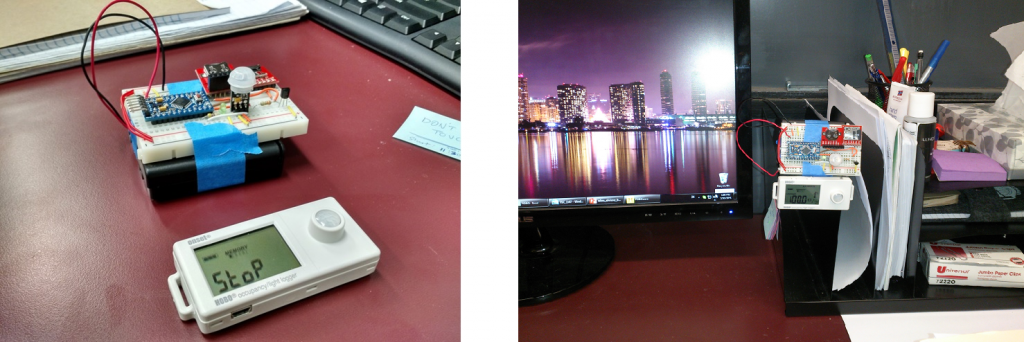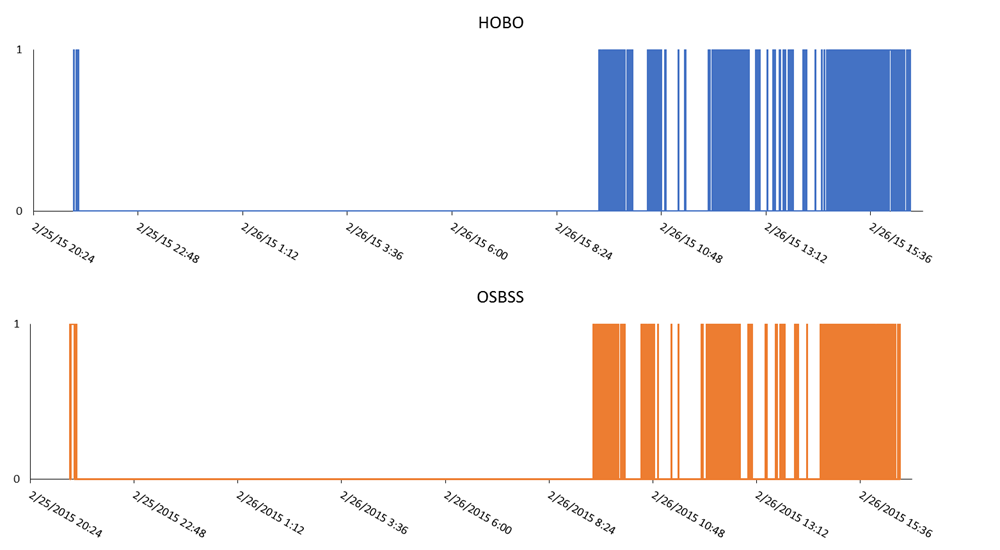Now that our new proximity data logger tutorial is published, I would like to show some data of its performance. Below are photos from a co-location test with the initial prototype OSBSS proximity sensor and an off-the-shelf Onset HOBO occupancy/light logger in our lab. In our first test we simply launched both sensors with default settings and placed them side-by-side on the desk of a graduate student to record occupancy over a period of about 15 hours (we’re watching you, Parham!).

Results from the first 15 hour co-location test are shown in the graphs below. They reveal very similar patterns and both appears to function similarly, although with some minor differences. For one, the absolute number of detected motion states were higher with the OSBSS device than with the HOBO. One issue is that there is an enclosure surrounding the edges of the HOBO while the OSBSS sensor is free standing. According to the user manuals, the angle of detection of the OSBSS PIR sensor is ~100° while the detection angle of the HOBO is ~87°. So the OSBSS proximity sensor may be detecting movement within a wider range. However, the Onset HOBO occupancy sensor actually has a wider sensitivity range (up to 5 meters) than the OSBSS sensor (PIR Mini Sensor, up to 3.65 meters), so it’s not clear how the combination of these two affected results. Another interesting thing to note is that the PIR Mini sensor in the OSBSS device was set to activate motion detection every ~2 seconds, while the HOBO sensors have a timeout period of around 1 minute by default. Thus, much of the higher rates of detection with the OSBSS device could probably be explained by simply having a greater sensitivity in time. More testing is currently under way, but initial results are very promising!

Update 02.26.2015:
A few days ago I built my own proximity sensor following the tutorial. It took me about 2.5 hours to build, but most of that time was spent soldering (I am not a soldering expert yet!). It should take others less time. I then launched my OSBSS proximity sensor along with the same Onset HOBO occupancy/light logger and repeated a similar co-locations test as above. However, this time I changed the timeout period of the HOBO sensor from the default value of 1 minute to 2 seconds to operate in the same was our OSBSS proximity sensor. The results are shown below:

These results are even more encouraging! Both sensors detect motion in a very similar pattern. It appears that Parham left his desk around 9 pm Wednesday night and returned around 9 am the following morning. It also looks like he’s most active in the afternoons. I think it is safe to say that our OSBSS proximity sensor is working quite well!

